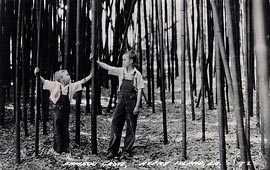
Jungle Gardens
Avery Island, Louisiana
Bamboo Groves Avery Island, Louisiana
History Continued

(above) Bamboo Grove, circa 1933.. Courtesy McIlhenny
Company/E.A. McIlhenny Enterprises, Inc., Avery Island, LA.
In its early years, the United States Department of Agriculture (USDA) relied heavily on "cooperators" to test different growing environments for propagating new plant species. These cooperators were contracted growers, overseen by the USDA so the organization could test new species in a variety of environments prior to establishment of the organization's own plant introduction stations. In 1910, McIlhenny contracted with the USDA to grow bamboo. The first shipment, an entire carload of bamboo samples, was planted that same year and by 1913, McIlhenny's plantings had surpassed all of the other USDA experiments in the country. Many of the USDA's growing stations, including those in Florida and Maryland, were unsuccessful in growing bamboo. However, McIlhenny's superior understanding of the plant led to his success with a diversity of species. In 1918, McIlhenny's bamboo was doing so well, he wrote that the USDA was welcome to take up to 1,000 plants without causing harm to the groves and by 1923, McIlhenny had almost 45 acres of bamboo, including several varieties that were not found anywhere else in the United States. By 1929, Avery Island was home to 64 varieties of bamboo. In 1935, McIlhenny opened his gardens to the public.

As McIlhenny's experience with bamboo increased, his writings on the subject proliferated and came to include several articles in National Horticultural Magazine. By the 1940s, McIlhenny boasted the only commercial bamboo plantings in the United States, supplying tuna poles to Pacific Coast fisherman and ski poles to the US military. However, as was true all across the nation, World War II had a significant effect on Jungle Gardens. For the first time, McIlhenny was unable to gather the labor required to continue fully maintaining the gardens. Moreover, McIlhenny's family business had grown successful, increasing his responsibilities and leaving him less and less time to focus on his precious plantings.